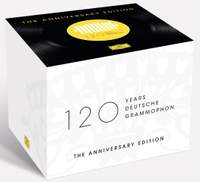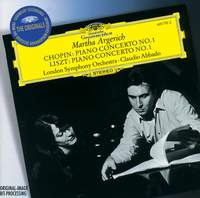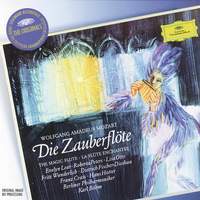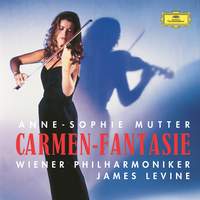Interview,
Clemens Trautmann on DG120
 As many of you will be aware, one of the most prestigious classical labels on the block celebrates its 120th birthday this year: Deutsche Grammophon was founded by Emil Berliner in 1898, and they’re marking the anniversary with a fascinating commemorative boxed set as well as numerous live events, including a recent Carmina Burana in the Forbidden City and a gala concert in Berlin this evening. (You’ll be able to watch the latter via live-stream from 8pm CET here). I met up with DG's President, Dr Clemens Trautmann, on one of his recent visits to London to talk about the challenges and rewards of running a major record-label, his own musical background and passions, and how the anniversary celebrations offer an opportunity to look to the brand’s future as well as its distinguished past…
As many of you will be aware, one of the most prestigious classical labels on the block celebrates its 120th birthday this year: Deutsche Grammophon was founded by Emil Berliner in 1898, and they’re marking the anniversary with a fascinating commemorative boxed set as well as numerous live events, including a recent Carmina Burana in the Forbidden City and a gala concert in Berlin this evening. (You’ll be able to watch the latter via live-stream from 8pm CET here). I met up with DG's President, Dr Clemens Trautmann, on one of his recent visits to London to talk about the challenges and rewards of running a major record-label, his own musical background and passions, and how the anniversary celebrations offer an opportunity to look to the brand’s future as well as its distinguished past…
You were appointed President of Deutsche Grammophon in September 2015 - could you talk me through your path to the role?
That path has been rather uneven. I started out as a clarinettist, training with Sabine Meyer and her husband Reiner Wehle at Lübeck Conservatory. When I was 20 I applied for a Masters programme at Juilliard and was – to my amazement – accepted into the studio of Charles Neidich, who had made wonderful recordings of the Mozart and Weber concertos for DG. Charlie was my teacher for two years, then I completed my musical studies with Sabine and Reiner. In parallel, I enrolled in law school, because I didn’t see my professional future in an orchestra or at a conservatory. What I really wanted to do was chamber music, and I’ve pursued this very passionately: the conductor and pianist Cornelius Meister was my duo partner for twelve years, and I played with the Amaryllis, Diogenes, Klenke, Mandelring and Panocha quartets on a regular basis. Before I joined Deutsche Grammophon, I served as managing director of an online property portal which belonged to the publishing group Axel Springer and helped to merge that company with the next largest competitor, kind of replicating the merger of PropertyFinder and Zoopla in the UK. After that I was ready for a new mission: certain people in the industry remembered that I had a musical background, as I’d continued performing throughout my career as a media executive, and one day I got a call from a head-hunter asking if I was interested in a conversation about DG…
Do you see any obvious parallels between working in property and running a record-label?
The basic mechanisms of running a company and motivating your team – and not least about digital marketing – are very comparable. When I joined that property company it was still a mature start-up: it had only existed for ten years (as opposed to the 120-year-old DG!), and I think it’s important for a company like DG to keep that entrepreneurial spirit alive. It’s embedded in our history and our DNA, because it was an entrepreneur, Emil Berliner, who not only founded the label in 1898 but also invented the gramophone, so there’s always been a very close interplay of creative content and technology at DG.
As a young musician and record-buyer, when did you first become aware of the Deutsche Grammophon brand, and what associations did it have for you?
I spent many happy afternoons during my teenage years browsing in record stores, and my buying habits were very much repertoire-driven: I was always looking for the definitive version of a certain symphony cycle or opera, and I quickly came to regard the DG logo as a seal of quality. That’s the idea that we are trying to replicate today, by bringing back the large yellow cartouche to provide orientation for listeners and people with tight time-budgets: the hope is to direct people towards what is really worth listening to, where your listening-time is truly well spent. My own personal experience as a buyer and listener has certainly influenced me in trying to factor this into our strategy. Maybe there’s a downside: the security that certain artist-names and label-brands provide can mean that you miss out on some discoveries, so I feel we have an obligation to point listeners towards emerging artists and repertoire that’s slightly off the beaten track as well as towards definitive accounts of the classical canon.
How involved are you in the artists and repertoire side of the label, and how is your time divided?
A&R is really the very core of our business: I spend a lot of time with my producers to fit the right artist to the right repertoire, and I think it’s probably an advantage here that I’ve actually recorded and performed professionally myself, though obviously far from DG’s level. We’ve made some great signings over the last three years: among those are legends like Murray Perahia and Lang Lang (who has returned to the label), and two outstanding conductors in their late thirties/early forties, Andris Nelsons and Yannick Nézet-Séguin. We’ve also recruited exciting new artists like Nadine Sierra, Kian Soltani, and Víkingur Ólafsson. Víkingur is particularly interesting, as he bridges the space from classical repertoire to the evolving roster of contemporary artists and composers active in minimalist and electronica music. Max Richter is one of the pioneers in this field that some people refer to as “neo-classical”, and in the past three years we have started collaborations with Agnes Obel, Peter Gregson and late Jóhan Jóhannsson.
My time is really divided between four areas: besides A&R there’s marketing and distribution, digital strategy and new business, and of course HR and general administration, especially changing the corporate culture and general mindset towards the digital ecosystem. That’s a lot of work, but it’s very rewarding: I really do love my job, and I guess that makes you go the extra mile. It involves travelling a lot, particular for the DG120 anniversary – our celebration of that is going to be very international, and a substantial part of it will be in Asia, so I’m flying out there on a bi-weekly basis at the moment. It’s been a great experience, as it’s a very vibrant and serious classical community; we’re working with our colleagues at Universal Music in China, Japan and Korea, as well as with the Shanghai Symphony Orchestra and Maestro Long Yu, who have a very strong domestic profile but also do a substantial amount of international touring.
Why is 120 years – as opposed to, say, 125 or 150 – such a special anniversary for the Yellow Label?
One reason is the significance of certain numbers in different cultures: the figures 12 and 60 have a special relevance in Asian territories, and 120 is considered the double completion of a life-cycle. It was actually partners from Korea who approached us with the idea of celebrating this particular anniversary. Recently we promoted a concert at the Forbidden City, which included Daniil Trifonov playing Rachmaninov’s Second Piano Concerto (coinciding with the release of his album Departure: Destination Rachmaninov), followed by Carmina Burana with an international cast of Aida Garifullina, Toby Spence and Ludovic Tézier and the Wiener Singakademie. What’s interesting about this is that the Latin texts for Carmina Burana, written by Bavarian monks, actually came into being at roughly the same time as the Forbidden City. This coming December there’ll also be a DG120 concert in Tokyo, headlined by Anne-Sophie Mutter and Seiji Ozawa, and another in Seoul with Myung-Whun Chung and Seong-Jin Cho.
We're also hosting gala concerts in all of the major cities in Germany where DG is or was once headquartered: Berlin, Hamburg and Hannover. There will be also a notable concert in the UK within the framework of DG120 - a Bach marathon on May 1st in the Royal Albert Hall, starting with Víkingur Ólafsson, followed by Peter Gregson, and with Clark taking over for the finale.
Furthermore, we’re bringing the concept of Yellow Lounge to Asia, with a series of six Yellow Lounges in all of the major Asian capitals: the ambition is to really reach out to the younger demographic and convey the beauty and power of classical music. Yellow Lounge is already very well established in Berlin and other cities, where we bring performances of classical works by high-level musicians into the urban atmosphere of clubs. That really attracts a completely new crowd, a crowd that has no preconceptions or biases about classical music, and it’s quite beautiful to experience that immediacy.
As well as looking to the future, do you also see the anniversary as an opportunity to tell the label’s story and celebrate its legacy?
Absolutely. Another important aspect of DG120 is the historic element, which ties in with the release of roughly 400 shellac tracks – we’re making these available digitally, but also in select physical editions, including a vinyl with highlights from The Shellac Project. It’s a fascinating music history lesson, for instance when you hear Titta Ruffo singing Valentin’s Prayer from Faust in a much slower, more expansive tempo that we’re used to today. And it hasn’t been released yet, but we were also able to capture an early DG recording which Leo Tolstoy made of him reading his own texts: he’s actually reading in German and French. Also, there are great discoveries of shellac recordings by Pietro Mascagni, Erich Kleiber, Fritz Kreisler and Louis Armstrong. These recordings will be featured on the DG120 anniversary edition, but also in smaller volumes on vinyl.
What would be your fantasy recording-project on the label, given unlimited budget and studio-time?
I’m put in mind of that Wagner quotation where he says that he still owes Tannhäuser to the world – well, maybe the recorded music industry still owes the definitive Ring Cycle to the world! The Solti/Culshaw set is amazing, but they had to make a lot of compromises, e.g. George London sings Wotan in Rheingold, and from Walküre onwards it’s Hans Hotter; then there is the great Karajan cycle from Berlin, but again he needed to make some concessions in terms of casting. And now with the new possibilities presented by surround-sound and immersive recording technology, all of the effects that Wagner actually put into the score could be realised (at least with unlimited budget!), and I’d also give it an audio-visual layer.
Let’s say you were to curate a small boxed set which sums up the Deutsche Grammophon philosophy for you – which albums would feature on that?
Let me start with the very first DG recording that I came across, which is the Karl Böhm Zauberflöte from 1963: I love the blend of naivety and wisdom in that recording. The wonderful cast includes Fritz Wunderlich and Dietrich Fischer-Dieskau, both of whom very much embody the post-War history of DG, and to have them interacting as Tamino and Papageno is something rather magical. Also, I’d have one of DG’s very best-selling albums of all time – Anne-Sophie Mutter’s Carmen Fantasy. I used to listen to that album for days as a child with my family, and whilst the virtuoso display-pieces are very impressive my favourite track on it is Wieniawski Légende, which is strikingly beautiful.
Then there's the Argerich/Abbado recording of Chopin and Liszt concertos with the London Symphony Orchestra (with a slow movement of the E Minor concerto to die for), the recent Krystian Zimerman recording of the late Schubert sonatas, and the Gidon Kremer/Wiener Philharmoniker Glass and Schnittke album, which I think was absolutely ground-breaking: Gidon has always championed new music, and I thought that was a very bold statement. Hearing the Wiener Philharmoniker in this repertoire is also quite special: I’m not sure that would happen these days, but it’s a real testimony to the versatility and creativity of that orchestra. Alongside another iconic DG album, Steve Reich’s Drumming, it paved the way for the minimalist movement that we’re continuing today with our contemporary roster. My hope and ambition is that everything we do at DG these days ties back to what has made the label relevant in the past.
Released on 5th October to celebrate the 120th birthday of the 'yellow label', this beautifully-curated set charts the evolution of Deutsche Gramophone through 120 iconic recordings, supplemented by four newly-commissioned essays exploring distinct periods in the label's history as well as twelve shorter pieces on genre. Also includes the complete Karajan Ring Cycle on blu-ray audio.
Available Format: 121 CDs + Blu-ray Audio
This evening's gala concert from the Berliner Philharmonie (featuring Anne-Sophie Mutter, Lang Lang, the Staatskapelle Berlin and Manfred Honeck in a programme of Beethoven, Mozart and John Williams) will be live-streamed from 8pm CET - you can watch via the link below. (Customers in France and Germany can access the live-stream here).
Recordings referenced in this interview
Martha Argerich (piano), London Symphony Orchestra, Claudio Abbado
Available Formats: CD, MP3, FLAC
Gidon Kremer (violin), Wiener Philharmoniker, Christoph von Dohnányi
Available Formats: MP3, FLAC
Fritz Wunderlich (Tamino), Dietrich Fischer-Dieskau (Papageno), Evelyn Lear (Pamina), Roberta Peters (Königin der Nacht), Franz Crass (Sarastro), Hans Hotter (Sprecher), Lisa Otto (Papagena), James King (Erste Geharnischter), Martti Talvela (Zweite Geharnischter); Berliner Philharmoniker, Karl Böhm
Available Formats: MP3, FLAC
Anne-Sophie Mutter (violin), Wiener Philharmoniker, James Levine
Available Formats: MP3, FLAC, Hi-Res FLAC
Krystian Zimerman (piano)
Available Formats: CD, MP3, FLAC, Hi-Res FLAC
Charles Neidich (clarinet), Orpheus Chamber Orchestra
Available Formats: Presto CD, MP3, FLAC









